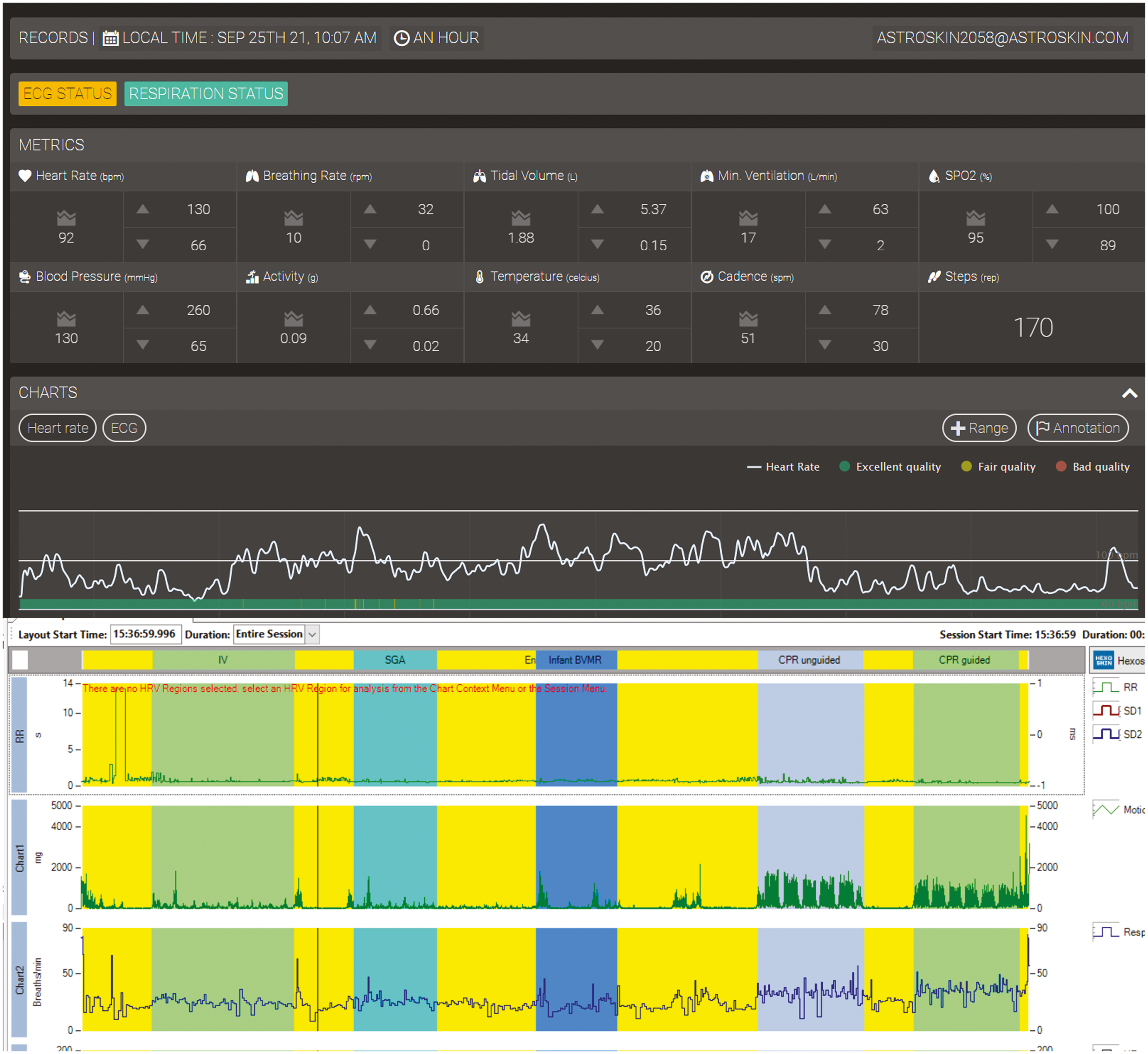
The ability to non-invasively monitor physiological changes in healthcare providers in simulation settings is important as it can provide insights into the hidden internal states of individuals. Physiologic monitoring has been used successfully in clinical settings [1]. In simulation, it can yield insight into stress responses, anxiety and may contribute to understanding the effect of cognitive load [2]. Smart textiles or biometric shirts capable of physiologic monitoring are becoming widely available and have been shown to be reliable and valid in several environments.
While subjective measures of participant performance are important, the ability to measure accurately and objectively other variables is emerging. For instance, heart rate, heart rate variability, respiratory rate and accelerometry can inform the design and execution of simulations, for example, understanding fatigue development during CPR performance and understanding stress response during simulation. Such insights can guide optimization of the use of healthcare simulation.
These are measurable by the biometric shirt, Hexoskin, a ‘wearable’ physiological monitor (Carre Technologies, Montreal, Quebec, Canada) which we have used in simulation research [3,4]. To this, we recently added the Astroskin, recently released following trials with astronauts on the International Space Station. Development of Astroskin has resulted in the added ability to continuously monitor blood pressure, blood oxygenation and temperature. We suggest these may become important in simulation research.

![Comparison of the features of the Hexoskin and Astroskin biometric shirts. (Hexoskin Health Sensors & AI. Astroskin Space-Grade Smart Garments [Internet]. 2023. Available from: https://www.hexoskin.com/pages/astroskin-vital-signs-monitoring-platform-for-advancedresearch).](/dataresources/articles/contents-1679329741403-356549aa-06a8-4f31-84bf-feaf46d1325d/assets/polx6384f0001.jpg)
Comparison of the features of the Hexoskin and Astroskin biometric shirts. (Hexoskin Health Sensors & AI. Astroskin Space-Grade Smart Garments [Internet]. 2023. Available from: https://www.hexoskin.com/pages/astroskin-vital-signs-monitoring-platform-for-advancedresearch).
With the established capabilities of the Hexoskin, we felt that the addition of monitoring blood pressure, blood oxygenation and skin temperature would be useful. Most particularly, it has been difficult measure continuous blood pressure, with devices such as the Holter Ambulatory Blood Pressure monitor being very bulky and not lending itself to the busy healthcare simulation settings.
Both the Hexoskin and Astroskin can connect via Bluetooth to an iPad, allowing for ‘real-time’ observation of physiologic changes in participants. Data are collected in a data pack which is part of the shirts. At the end of the simulation, these data are uploaded to a cloud server and undergo first-pass analytics on the Astroskin or Hexoskin Dashboard. We then download that data file for further analysis and annotation in Vivosense (Vivonoetics, San Diego, CA, USA) or Kubios (Kubios Oy, Kuopio, Finland).
Figure 2 illustrates an example of de-identified physiologic data as it appears on the Astroskin dashboard and (below) after further processing using Vivosense. Note the green annotations are showing a participant performing CPR.


Illustrating the Astroskin dashboard (top) and the data after further analysis in Vivosense.
Following several years of using the Hexoskins, we recently deployed the Astroskin in pilot testing work in several simulation settings examining the effect of level of immersiveness and the effect of a mindful breathing intervention on clinical and physiologic performance of paramedicine students.
Because this was pilot testing of methodologies, we were interested in the ease of deployment by researchers and the opinion of the participants in how wearing the shirt felt. Full quantitative validation of the data quality has been conducted and will be published separately [5].
Similar to the Hexoskin, researchers were able to instrument participants with Astroskins quickly with an estimate of less than 10 minutes per participant. Further, participants found the shirts themselves are unobtrusive and reported no discomfort while wearing them. One participant noted: ‘It was a little distracting initially, but once in the simulation you don’t even notice it is there. I had it on for an hour and it was not bad at all to wear’. Another ‘it fit quite well, comfortable and adjustable. The headband felt a little strange and I quickly got used to it’.
Hexoskins are well-validated for research in several settings. Following from that, we have just completed a validity and reliability study on the Astroskins comparing measurement to a Corpuls monitor, currently undergoing review [5]. Our next steps are to carry out appropriately powered studies using the Astroskin biometric shirts and to further refine our methodologies.
While our research focus is on measuring and understanding (for instance) the role of physiological variables linked to stress and fatigue during healthcare simulations [1,2] we look more widely in terms of other researchers and institutions who may value this type of data collection.
Our goal is to utilize the technology of biometric shirts to enhance the simulation learning experience, inform educators on simulation design and delivery and establish peak performance across healthcare providers.
1.
2.
3.
4.
5.